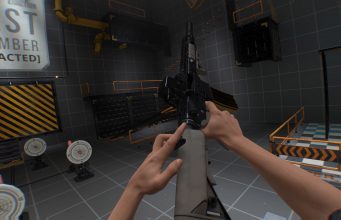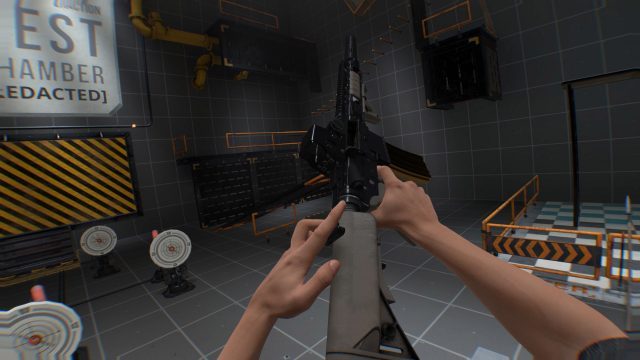
Boneworks by Stress Level Zero is described as a narrative VR action-adventure using advanced experimental physics mechanics. In this article, we check out the game’s core mechanics.
Cas and Chary VR is a YouTube channel hosted by Netherland-based duo Casandra Vuong and Chary Keijzer who have been documenting their VR journeys since 2016. In partnership with the channel, Road to VR shares a curated selection of their content.
In Boneworks, you enter an artificially intelligent operating system called; MythOS. Something mysterious has happened in the operating system, and it’s up to you to find out what that is. Throughout the game, you’ll enter a variety of levels in the story mode, and you progress through them by doing physics-based puzzles and combat.
The game has three game modes: Story mode, Arena mode, and Sandbox mode. The Arena mode unlocks after you finish the story and you can unlock the Sandbox mode earlier in the game in a specific way, but I won’t spoil that for you.
One of the first levels is an extensive tutorial that’s basically a museum that you walk through, and at every exhibit, you learn how to use the game’s mechanics. Not only does this level teach you what locomotion options there are, but it also shows you most of the weapons and items available in the game and how to interact with the environment using physics.
You probably heard of Boneworks before if you keep up to date about VR games since there is a lot of hype around this game. But what makes this game so exciting? The heavy use of physics simulation in the game is something you don’t see often in VR games because it’s very challenging to do right. Most games have scripted interactions which use static logic to determine outcomes (like swinging a sword at an enemy will deal X damage), but much of the logic in Boneworks is based on physical simulation.
In the video, around the 03:00 mark, I show you these VR interactions with physics-driven items. For example, each weapon has its own weight. If you try holding a sledgehammer with one hand, it’s almost impossible for you to accurately slam it on a barrel because it’s too heavy to carry it with one hand. With two hands it’s easier, but still, a sledgehammer does not act the same as a lighter weapon.

The developers added realistic colliders in almost every object, and instead of forcing you to grab an item at one specific spot like most games do, the item is grabbable on far more places. Being able to hold an object how you want gives you much more freedom to use it creatively (like holding a dagger with an underhand or overhand grip). Some of these things might seem like small things, but they can greatly enhance the feeling of immersion and agency in the game.
There are also other mechanics that I like. For example, there is ‘force-grab’ which allows you to grab items from a distance, so you don’t have to crouch down to pick up items from the ground. The realistic weapon handling makes for some exciting combat, especially when you forget how to reload a weapon in the heat of the moment when there’s a bunch of creepy zombies coming at you. Thanks to the physics, you can improvise–throw your gun at the zombie and start swinging with your fists! I also like the inventory system that shows you the open slots on your body to put your equipment.
While I can tell that the developers put a lot of passion into the physics mechanics in the game, some parts weren’t as exciting to me. The story, for instance, is very mysterious, but even three hours in, I still don’t feel like I’ve been grabbed by it.
While I enjoy the physics mechanics, it also makes for some awkward movements and interactions. For example, I could get my arms or body stuck between two pipes, and I would struggle to get myself out. Those awkward moments also make the game pretty intense comfort-wise. If I don’t watch out, I have a hard time playing long periods without getting motion sick. Motion sickness is a very personal thing, though, so I would not take my word on it before trying it out yourself. However, since these intense moments seem to be caused by the physics-driven gameplay, I feel like I had to mention it. There are some comfort options to choose from in the controller settings menu, like head or hand-related locomotion that could help out, but the game warns you from the very start that it is intense.
So far, I’ve also found more puzzles than combat. The puzzles are huge, and to solve them, you need to use the environment around you creatively. There are multiple ways to solve a puzzle, and I like that. They can be head-scratchers, though, and it might get frustrating at times, but anyone who likes puzzle games would probably see this as a challenge.
Some other things I like is that the game rewards exploration. You can find and collect ammunition in every level which also acts as currency to get new items and weapons out of wall dispensers. The game is also full of secrets and easter eggs which are fun to seek out.
Boneworks by Stress Level Zero is out now for $30. The game supports most major VR headsets: Valve Index, HTC VIVE, Oculus Rift, and WMR. I’ve played the game on the Valve Index with the Index controllers myself, and I’ve also tried the Oculus Rift S and the Touch controllers. Both headsets play well with the game.
I recommend everyone who likes exploring VR games to check out this game. You probably don’t want to get this game just for the story, but you will want to check out these physics-driven implementations.
The post Cas & Chary Present: ‘Boneworks’ Physics-driven Mechanics and Gameplay Overview appeared first on Road to VR.
Ream more: https://www.roadtovr.com/boneworks-physics-driven-mechanics-gameplay-overview/

No comments:
Post a Comment